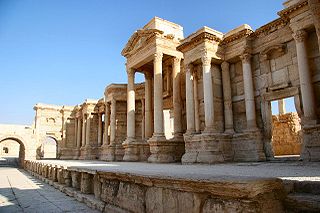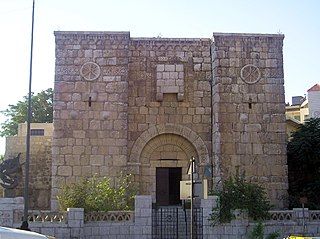The 630s decade ran from January 1, 630, to December 31, 639.

Year 634 (DCXXXIV) was a common year starting on Saturday of the Julian calendar. The denomination 634 for this year has been used since the early medieval period, when the Anno Domini calendar era became the prevalent method in Europe for naming years.

The Battle of the Yarmuk was a major battle between the army of the Byzantine Empire and the Arab Muslim forces of the Rashidun Caliphate. The battle consisted of a series of engagements that lasted for six days in August 636, near the Yarmouk River, along what are now the borders of Syria–Jordan and Syria-Israel, southeast of the Sea of Galilee. The result of the battle was a crushing Muslim victory that ended Roman rule in Syria after about seven centuries. The Battle of the Yarmuk is regarded as one of the most decisive battles in military history, and it marked the first great wave of early Muslim conquests after the death of the Islamic prophet Muhammad, heralding the rapid advance of Islam into the then-Christian/Roman Levant.

The Muslim conquest of Persia, also known as the Arab conquest of Iran, was carried out by the Rashidun Caliphate from 632 to 654 and led to the fall of the Sasanian Empire, as well as the eventual decline of the Zoroastrian religion.
The Battle of Hazir or Ma'arakah al-Haadhir took place between the Byzantine army and the Rashidun army's elite cavalry, the Mobile guard. It took place in June 637, three miles east of Qinnasrin at Al-Hadher in present-day Syria.

The Battle of Walaja was a battle fought in Mesopotamia (Iraq) in May 633 between the Rashidun Caliphate army under Khalid ibn al-Walid and Al-Muthanna ibn Haritha against the Sassanid Empire and its Arab allies. The Sassanid army is said to have been two times the size of the Muslim army during the battle.

The Battle of Ayn al-Tamr took place in modern-day Iraq (Mesopotamia) between the early Muslim Arab forces and the Sassanians along with their Arab Christian auxiliary forces. Ayn al-Tamr is located west of Anbar and was a frontier post which had been established to aid the Sassanids.
The Battle of Daumat al-Jandal took place between Muslims and Rebel Arab tribes in August 633 CE. This was a part of the Riddah wars. Daumat al-Jandal was given to Iyad ibn Ghanm to crush the rebels, but he failed in doing so, and send for help to Khalid ibn Walid who was in Iraq in those days.

Battle of Muzayyah was between the Muslim Arab army and the Sasanian Empire. When Khalid ibn Walid left from Ayn al-Tamr to Dumat Al-Jandal for the help of Iyad ibn Ghanm, the Persian court believed that Khalid had returned to Arabia with a large part of his army. The Persians decided to throw the Muslims back into the desert and regain the territories and the prestige which the Persian Empire had lost. The Persians had resolved not to fight Khalid again, but they were quite prepared to fight the Muslims without Khalid ibn al-Walid.

Battle of Saniyy was between the Muslim Arab army and the Sasanian Empire. When Khalid ibn Walid gone from Ayn al-Tamr to Dumat Al-Jandal for the help of Iyad ibn Ghanm, The Persian court believed that Khalid had returned to Arabia with a large part of his army, Persians decided to throw the Muslims back into the desert and regain the territories and the prestige which the Empire had lost. The Persians had resolved not to fight Khalid again, but they were quite prepared to fight the Muslims without Khalid ibn al-Walid. Khalid ibn al-Walid first defeated them at the battle of Muzayyah and then advanced towards Saniyy.

The Battle of Firaz took place around January 634 between the Rashidun Caliphate and the combined armies of the Sasanian Empire and the Byzantine Empire. It ended with a Rashidun victory, concluding the first Arab invasion of Mesopotamia.

The Muslim conquest of the Levant, or Arab conquest of Syria, was a 634–638 CE invasion of Byzantine Syria by the Rashidun Caliphate. A part of the wider Arab-Byzantine Wars, the Levant was brought under Arab Muslim rule and developed into the provincial region of Bilad al-Sham. Clashes between the Arabs and Byzantines on the southern Levantine borders of the Byzantine Empire had occurred during the lifetime of Muhammad, with the Battle of Muʿtah in 629 CE. However, the actual conquest did not begin until 634, two years after Muhammad's death. It was led by the first two Rashidun caliphs who succeeded Muhammad: Abu Bakr and Umar ibn al-Khattab. During this time, Khalid ibn al-Walid was the most important leader of the Rashidun army.

The Battle of Ullais was fought between the forces of the Rashidun Caliphate and the Sasanian Persian Empire in the middle of May 633 AD in Iraq, and is sometimes referred to as the Battle of Blood River since, as a result of the battle, there were enormous amounts of Persian Sasanian and Arab Christian casualties.

The Battle of Bosra was fought in 634 CE between the Rashidun Caliphate army and the Byzantine Empire over the possession of the city of Bosra, in Syria. The city was one of the Islamic forces' first significant captures and was at the time the capital of the Ghassanid Kingdom. The siege took place between June and July.

The siege of Damascus (634) lasted from 21 August to 19 September 634 before the city fell to the Rashidun Caliphate. Damascus was the first major city of the Eastern Roman Empire to fall in the Muslim conquest of Syria.

| strength1 = 18,000 | strength2 = 40,000 15-000-20,000 | casualties1 = Low | casualties2 = Heavy }}

The Battle of al-Qadisiyyah was an armed conflict which took place in 636 CE between the Rashidun Caliphate and the Sasanian Empire. It occurred during the early Muslim conquests and marked a decisive victory for the Rashidun army during the Muslim conquest of Persia.
Sa'd ibn Abi Waqqas ibn Wuhayb al-Zuhri was an Arab Muslim commander. He was the founder of Kufa and served as its governor under Omar ibn al-Khattab. He played a leading role in the Muslim conquest of Persia and was a close companion of the Islamic prophet Muhammad.
Al-Qaʿqāʿ ibn ʿAmr ibn Mālik Al-Tamīmī was an Arab Muslim commander and general in the Rashidun army who belonged to the tribe of Banu Tamim. He and his tribe converted to Islam possibly during the time of Ahnaf ibn Qais. He is known as a successful military commander who took part in two important victorious battles in the early Muslim Conquest, the Battle of Yarmouk against the Byzantine Empire and the Battle of al-Qadisiyyah against the Sassanian Empire which was led by Sa`d ibn Abi Waqqas. The Caliph Abu Bakr praised him as an equal to eleven thousand men so in return the caliph's successor, caliph Umar, only sent Qaʿqāʿ and a handful of bodyguards in the first wave of reinforcements to Al-Qadissiyah. Qaʿqāʿ was one of the most illustrious military figures of his era.

The Arab conquest of Mesopotamia was carried out by the Rashidun Caliphate from 633 to 638 AD. The Arab Muslim forces of Caliph Umar first attacked Sasanian territory in 633, when Khalid ibn al-Walid invaded Mesopotamia, which was the political and economic centre of the Sasanian state. From 634 to 636 AD, following the transfer of Khalid to the Byzantine front in the Levant, the hold of Arab forces on the region weakened under the pressure of Sasanian counterattacks. A second major Arab offensive in 636 and ended in January 638 with the capture of Mosul and the consolidation of Arab control over and exclusion of Sasanid influence from the whole Mosul-Tikrit region.











